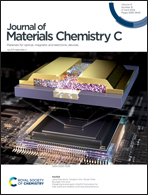The effect of precursor concentrations on the structure and optoelectronic properties of quasi low-dimensional hybrid 2-methylpyridinium lead bromide crystalline phases†
Abstract
This work presents the synthesis and optoelectronic properties of the crystalline phases [Pb2Br5][C6NH8] and [PbBr3][C6NH8] of 2-methylpyridinium lead bromide. Their synthesis is achieved by varying reactant concentrations. The first phase is an organometal compound with a corrugated quasi 2D structure, while the second one is a 1D hybrid structure. The optical bandgaps of the compounds are ∼3.4 eV, matching with the results of DFT calculations. Although their photoluminescence (PL) excitation spectra are nearly identical, the corresponding PL emission spectra are different with maxima at 2.22 eV and 2.84 eV for [Pb2Br5][C6NH8] and [PbBr3][C6NH8], respectively. The comparison of experimental and theoretical results suggests the existence of radiationless electronic transitions from the inorganic subsystem to the π-electron system of the 2-methylpyridinium cation.



 Please wait while we load your content...
Please wait while we load your content...